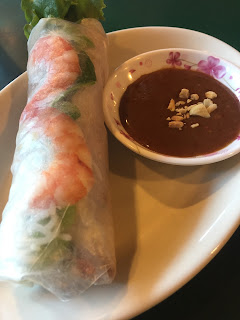 |
| Hard Hats required. |
Our tour guide, a forty year veteran of the Queen Mine, told us that rats and cockroaches were welcome in the mine because they had such sensitivities to the earth that if they ever started moving fast, it meant the miners should take heed. I think this is true in our political world as well. Midst all the bluster, obfuscation, pettiness, and payback, the flat fact is that the Democrats currently couldn't pass salt at a congressional luncheon. So what we need to do is watch the rats. When the Republicans start leaving the mine, that's when we'll know the chaos is real. Until then, live on and move on. In that vein (Get it?), our tour of the mine this morning reminded me of reality. Those in power make the rules. Money men of old justified copper mining because the country needed the mineral to aid progress. Today's money men will justify rolling back regulation because we need energy independence for our national security. In the short run, it just may work. Environmentally, who knows? But to paraphrase Ben Franklin, it's good to be a rational man in the event we have to make up reasons for the things we want to do. Regardless of the environmental destruction around Bisbee, and the slow up take to reclaim the land since 1975, the Queen Mine is awe inspiring. Our tour took to the eight hundred foot level, one of many. Our guide said there are hundreds of miles of shafts honeycombed inside this mountain. And the harvest was staggering: Between 1877-1975 miners extracted 8,032,352,000 lbs. of copper, 2,871,786 oz. of gold, 77,162,986 oz. of silver, 04,627,600 lbs. of lead, and 371,945,900 lbs. of Zinc. Those are just the numbers for this mine. There are three more like it in the area. And, Oh, my! the work in the early years was grueling. No air, candle light, hand tools, and ten hour days. It would take three or four days to pound and chisel one hole. Several were required before the miners could pack dynamite into the holes to blow a hole about eight foot by eight foot, by eight foot. Then the miners would have to shovel and load the debris to clear the area. The dust, a silica base, filled the air, and shortened miners lives. It sounds unbearable. Even when the early drills came to the industry, they were so unbelievably heavy, the work was still daunting. And when they introduced water and air compressed drills, the miners worked faster, but now in dark and wet conditions. I'm glad my grandfather, who mined coal in Pennsylvania and other ores in Colorado, didn't pass down mining as the family business. I can see why he turned to lumber jacking. I guess the prospect getting killed by a falling tree far outweighed the slow death of black lung, or the very real prospect of being crushed by several tons of rock in a cave in. When the tour was over, I was glad to see the light. I can imagine the same was true of the miners who worked under ground In addition, to the mine tour, we did manage to walk above ground nearly four miles and climb twenty-two floors. Like I said, there are no flat roads in Bisbee. We scored the trifecta by eating dinner at Thuy's Noodle shop. Thuy is a delightful Vietnamese woman who is simply a fabulous cook. The bottom line is that everywhere we ate in Bisbee was excellent. Judy commented that perhaps we've been eating a little too high on the hog. My respsonse: Visit Bisbee if you can because life here is good, especially today.

This train took us deep under ground.
These stairs lead to a Stope, which is a rich vein of various minerals.
The yellow air duct is an advantage the original miners didn't enjoy.
The shift bosses had to check various work sites in the mine, so they rode this bike.
This 3/4 ton ore cart was filled and pushed a few hundred feet by very strong young men who would then return and push another all the live long day.
An example of the first drills used which could drill the required holes in a few hours.
This modern version could drill the same hole in a few minutes.
Examples of the early, very heavy drills.
Every so often there is a chamber held up by timbers. These chambers were staging areas where the miners kept equipment and supplies.
This front loader, which is hooked to a one ton ore cart, could clear several tons per hour.
This gray streaked piece of ore is called "Leavit" (Which means leave it, it ain't worth nothing).
Judy thought she deserved some Flan after her long shift in the mine.
Pork spring roll at Thuy's.
Fresh roll at Thuy's.
Chicken Pho.
Hot Rod of the day. We'll see you next time we're in Bisbee.

















No comments:
Post a Comment